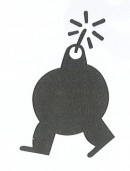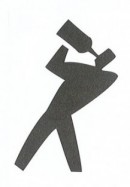Grim(m) stories?
30 April 2010 | Letter from the Editors
 ‘There’s not been much wit and not much joy, there’s a lot of grimness out there.’
‘There’s not been much wit and not much joy, there’s a lot of grimness out there.’
This comment on new fiction could have been presented by anyone who’s been reading new Finnish novels or short stories. The commentator was, however, the 2010 British Orange Prize judge Daisy Goodwin, who in March complained about the miserabilist tendencies in new English-language women’s writing.
Jouni Avelin, editor of Kulttuurivihkot (‘Cultural notes’) magazine, said in this year’s first issue: ‘There are two themes in new Finnish fiction: men’s mid-life crises and young women’s erotic adventures – all Finnish literature is the literature of anxiety…. Sex is never nice, life stinks, shoes pinch….
‘The main character hates himself and his mother, who loathes her husband, who can’t stand his children or his parents, who hate everybody who enters the house, either through the door or the TV set. All suffer save suffering itself…. The novel is always the main character’s confessional: life is the same as life in other novels.’
It has to be admitted that playful, happy and sunlit fiction is slightly on the rare side, as we have cause to note, year after year, at the Books from Finland offices. Not surprisingly, as virtues are so much more boring than vices.
And the grimmest genre of all, crime literature, very popular in the Scandinavian countries – as well as in Finland – has been very exportable, as is proved by the best-selling lists of translated fiction all over the world. Stieg Larsson, Henning Mankell, Liza Marklund, Håkan Nesser…. Leena Lehtolainen and Matti Rönkä are two Finnish writers of crime literature who have recently become popular in Germany, in particular.
(It is somewhat puzzling why crime fiction, entertaiments dealing with death, murder and violence, is so abundant in these ‘welfare societies’ in the North. Can anyone explain? Has anyone tried?)
In the first issue of 2006 of Books from Finland the literary scholar Michel Ekman wrote under the title ‘Life is too short’, expressing a personal (and unusual) view: ‘What literary genre is more slavishly bound by the compulsion of plot than the detective and the thriller? (And consequently, more stereotyped in its particulars and its structure.) Opera, of course, and one can just imagine the joy of watching Tosca without music.’
In contemporary Finnish drama, the nuclear family is definitely a huge favourite; skeletons rattle in the cupboards as grim primary relationships are taken out for an airing, the traumas of the Winter War are omnipresent, lovelessness continues unto the third and fourth generation and the fear of a global ecological disaster paralyses the young.
 The grim stories occasionally bring to mind those dark 19th-century fables of those German fabulists, the Grimm brothers: in them people are burnt alive, chopped to pieces and tortured: early crime literatur – for children!
The grim stories occasionally bring to mind those dark 19th-century fables of those German fabulists, the Grimm brothers: in them people are burnt alive, chopped to pieces and tortured: early crime literatur – for children!
It’s not that life isn’t sometimes grim and that fiction shouldn’t be written about it – it’s just that the weighty realism of fiction often falls on to the reader’s neck like a ton of bricks, as do the repeated patterns of this modern miserability. (Thanks, Mr Chekhov, for your philosophy – to quote you freely, art should depict life as we see it in our dreams, not only just as it is or as it should be.)
Coming up soon on this site is a fantastic story for you to read, set in a (sc-fi-ish) future, about the similarities between silicone and human flesh, by Tiina Raevaara; it may not be a very sunny story, rather a grim(m) fable, but we think it’s exciting, and not without humour. We’ll be introducing some new drama, too – Finnish drama has been enjoying renewed success at home in recent years and is now also getting exported – with themes other than devastating family life.
You’ll find samples of fiction on this page in which life is not ‘the same as life in other novels’, so stay with us!
Tags: novel, publishing, short story
No comments for this entry yet
